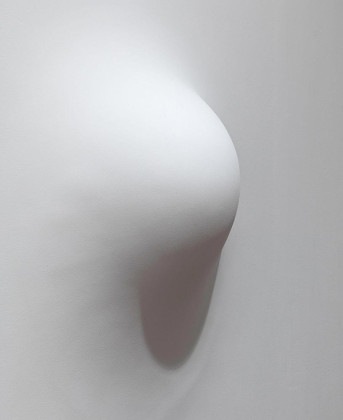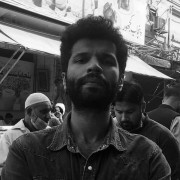Sign Towards the Void
What is important is that at a certain moment one achieves the illusion. Around it lies a sensitive point, a focus of pain, a point where all history turns upside down insofar as it is the history of art and we are included in it; This point relates to the idea that the illusion of space is different from the creation of emptiness. 1
Jacques Lacan, Ethics
Suggesting that the presence of an object can make a space emptier than mere emptiness could ever dream of might be one of the most valuable insights into Anish Kapoor's work. This quality of extreme, generative emptiness can be seen throughout his work. It is a process of "retreating into a depth that holds open the whole matter of the surface, the surface tension, marking and creating a new surface", which he associates with the opposing but still related forces of withdrawal and revelation. For example, consider the figure of "Adam". A cavity so deeply set in a stone that its pigmented veil defies the depth of the rock and floats weightlessly towards the surface. Suddenly, he shifted the mass of stone, leaving only his shadow and creating more ground than he stood on. Or wander around the quiet bulge of "When I am Pregnant". Trace the shape growing obliquely outward from the wall, and then when you suddenly stand face to face in front of it, it is no longer there; when the wall changes from white to light, only a bright halo remains to return you to the memory of fullness. The monumental and noumenal address of Kapoor's work should not obscure these uncanny experiences, which suggest that his broad tolerance of empty space extends available space into another ongoing discontinuity of "time".
We are often called upon by critics to stand in front of Kapoor's voids; we witness the virtues of modernist verticality, which Rosalind Krauss rightly describes as a process by which "apparent disorder... is reabsorbed into the fact of being necessarily limited". 2 However, the expansion of existing space - the creation of space - never registers a lateral movement, a transitional jolt that disrupts the limitation of space. The space shifts sideways from the grasp of the frame and the figure; The visual perception of what is integrated and present in the viewer's eye as contained absence is weakened. The enigma of the void can now be discerned in the implication of a movement that obliterates perceptual space and complements it with a destructive, disjunctive time that the viewer must traverse – "invert, confirm, negate". It is this transitional temporality, affected by the expansion of space, that Kapoor seeks to record in the very passage of time and movement, that makes the exhibition a phenomenological experience. The Double Mirror works present a motif of the material techniques and metaphorical possibilities of "creating space", which is the subject of this article. Listen to the artist:
"… The interesting thing about double mirrors, concave mirrors, is that when you put them together, they don't give you infinite repeatability… What interests me is that there is no image in either mirror when viewed from certain angles and positions. I am very interested in the way they invert, confirm and then deny…. To place the viewer in this narrow passage with these blinding mirrors... in this transition area... somehow at an oblique angle to the 'visuality' of the mirrors or the visibility of the viewer means to get caught up in the race of mirrors. They cancel each other out in an instant, but still demand to be viewed from a strange, tortuous perspective... Where time and space seem to disappear, they stand... paradoxically, there is an uneasiness, an uneasiness in that narrow passage. … As I said before, it is a transitional movement – invert, confirm, negate." 3
The tactile transition experience is captured in the virtual space between double mirrors. The mimetic balance between the perspectival distance between subject and object, or between the mirror and its reflection, is replaced by a movement of erasure and inversion – "inversion, affirmation, negation". It is as if the possibility of pictoriality or image creation, which is associated with visual pleasure, has been destabilized in a way that reveals the void, the darkness, the blind spot. However, the purpose of Kapoor's work is not to represent the mediation of light and darkness or negative and positive space in a dialectical relationship in which the void passes through the darkening mirror and assumes the fullness of presence. By remaining in transition, Kapoor gives him time and space to develop his own affects (anxiety, restlessness), so that the viewing becomes part of the process of making the work itself. The viewer's relationship with the object primarily involves the process of questioning the basic conditions that enable the work to become a visual experience: How can the conceptual gap be made visible? How can one talk about the perceptual gap?
These questions stay true to Kapoor's point. It is not true in the mimetic sense of reflecting "reality" or revealing the perfection of aesthetic form. 4 But it is true of homo faber, whose eyes remain faithful to the process of production - flattening, smoothing, sharpening - to go beyond the measure of the “maker,” or the material, so that “a man's” products can be more - and not just more lasting - than he is. Kapoor's understanding of making emptiness emptier is the process by which the artist's reach exceeds the tiresome grasp of "personality" and refuses to allow this to be its source.
To consider emptiness as a style is to read its emptiness 5 as nothing more than a defense of the pictorial; What Clement Greenberg describes as "the appearance of the void": "Geometric and modular simplicity can announce and express the farthest, but understanding signals for what they mean betrays them artistically...: Ghosts of the Picture rectangle and the Cubist grid haunt his work and it demands to be filled with light and dark drawings, and so it is filled." Moving away from the appearance of emptiness, we propose instead: Truly created emptiness is produced from the "sign of emptiness". Talking about the "sign" of a work does not mean substituting theory for practice or leaving the visual experience of art to the written language. The "sign of the void" can neither be fixed in form nor preserved as an image or idea. It is "true" according to the construction and materiality of the object, but in its own way. In Greenberg's terms, it occurs when the "signals" of figuration or technique are prevented from expressing what they mean; when the demand to fill the void is resisted, the signature of the style can no longer name or claim to control the aesthetic logic of the work. Kapoor's spaces that appear before us as sculpted objects (the transformation of blue dust into the color of distant, alluring distance) are different from his creation of emptiness.
If you think you see the "void" as a hole at the heart of the material mass, surrounded by a planned façade, think again. 6 To see the void as a closed negative space indented into the material is only to grasp its physicality. To design the depth of emptiness in a way that ensures the absence of perspective within the framework or genre is to linger too long with the pedagogy of production or the technology of taste. The practice of 'making real' only occurs when the material and the immaterial come into tangential contact. What is actually done pushes us decisively beyond the illustrative, the "appearance of the void"; The space sign expands the boundaries of the available space. Kapoor's statement is as follows:
"I believe very deeply that works of art, or let's say, not just works of art, but things in the world can actually be made. If they are truly created in the sense of self-possession, then they are beautiful. If they are not really made, the eye is a very quick and very good instrument... The idea of what is really done has nothing to do with truth alone. This has to do with the meeting of the material and the immaterial… Something exists in the world because it has mythological, psychological and philosophical consistency. That's when something is really done..."
References:
1 Jacques-Alain Miller, ed., The Seminar of Jacques Lacan. Book VII – The Ethics of Psychoanalysis 1959-1960, trans. Dennis Porter, W.W. Norton & Company, New York, 1986, p. 140.
2 Yves-Alain Bois and Rosalind E. Krauss, Formless – A User's Guide, Zone Books, New York, 1997, p. 26.
3 Conversation: Anish Kapoor in dialogo con Homi Bhabha, https://www.youtube.com/watch?v=e2yfz3HOfgc&ab_channel=Galleriedell%27AccademiadiVenezia
4 Hannah Arendt, The Human Condition, University of Chicago Press, Chicago, 1958, p. 210.
5 John O'Brian, ed., Clement Greenberg: the Collected Essays and Criticism, vol. 4, Modernism With a Vengeance, 1957-1969, University of Chicago Press, Chicago, 1986, p. 251.
6 Ibid, p. 254.
Related Content:
-

Big Top: The Circus Canteen
-

Tarq Gallery
-

İşbank Painting Sculpture Museum
-

Sister Sylvester and Deniz Tortum's "Shadowtime" Poses a Virtual Reality Check at SXSW
-

The Paint Store
-

"Into The Space" By Nakamura Kazunobu Design-Works
-
Expanding Space: Transforming Honsberg through Art
In Germany Honsberg, a district of Remscheid with a rich history, the "Ins Blaue" project has been redefining urban spaces through art. Brought to life by a group of dedicated artists, this initiative has turned abandoned houses into vibrant studios, galleries, and event spaces. We have interviewed Katja Wickert, one of the curators of the organization and the artists involve - Vera Vorneweg, Adrienne Brehmer, Eva Wal and Hacer Bozkurt - exploring the inception of "Ins Blaue", this year's theme of "Expanding Space" and the impact of their creative endeavors on both the neighborhood and its residents.
-

LaCalor Serigraphy Studio
 15.12.2023
15.12.2023














